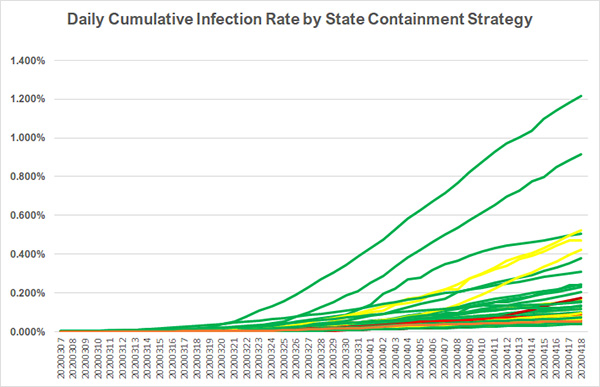 By Bill King
By Bill King
There has been a narrative in the media recently that a handful of states that have not issued “stay-at-home” orders are now suffering a rash of coronavirus cases as a result of their inaction. One CNN article alleged that there were eight states without “stay-at-home” orders experiencing a “spike” in new cases. Of course, the article points out that each of these states has a Republican governor.
Since the experience of states without such orders could be helpful data in determining the effectiveness of such orders, I decided to crunch the numbers.
First, according to the University of Washington’s Institute of Health Metrics and Evaluation(IHME), there are 12 states without stay-at-home orders, including somewhat surprisingly, Connecticut and Massachusetts.
IHME also used five other “containment strategies” in their modeling: school closures, mass gathering restrictions, “severe” travel restrictions, bar and restaurant closures and banning non-essential services. According to IHME, all of the states have closed schools and restricted mass gathering. None have imposed severe travel restrictions. The difference between the states lies in their treatment of the other three containment strategies.
IHME shows that only 27 states have adopted all three. Of the 23 remaining states, 18 have not banned non-essential services and only 3 have not closed bars and restaurants. I downloaded the positive test data for all 50 states from the COVID Tracking Project and calculated a cumulative infection rate for each state using the U.S. Census 2019 population estimates. Here are the results as of April 18:

The infection rate for all 23 states which have not adopted one or more of the recommended containment strategies is well below the national average. If you just look at the 8 states CNN called out, their infection rate is less half the national average.
This is a chart of all of the states’ daily infection rates since March 7. The states that have adopted all three containment strategies are shown in green. The states that have not adopted any are shown in red, one in orange, and two in yellow.

As you can see, it is pretty much a random distribution and the states that have skipped some of the containment strategies are bunched with the states with the lower infection rates.
I think there are three take-aways from this.
First and foremost, be very, very skeptical of anyone peddling partisan explanations for outcomes during this pandemic – from either side.
Second, also be skeptical of claims about large percentage moves in the numbers, especially over short time periods. The data reporting is very inconsistent on a daily basis. Some jurisdictions will skip a day and catch up the next. Testing comes back in batches. It is only looking at longer-term trends in the data that is meaningful.
Third — and I offer this more tentatively because the data is so incomplete – it appears that the same containment strategies are not necessary for all areas. What is needed in dense urban environments may not be needed in rural or even suburban areas. Of course, people can be crammed together in restricted spaces in rural or suburban settings like sporting events or the meat packing plant in South Dakota that experienced a serious outbreak. But I think what we are seeing is that one size doesn’t fit all.


